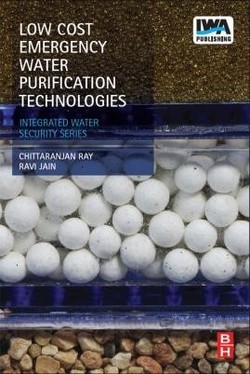
Low Cost Emergency Water Purification Technologies
Integrated Water – Security series
By
Chittaranjan Ray and Ravi Jain
Preface
Access to clean water is of serious concern to the human population. Incredible as it may seem, more than one billion people do not have access to adequate water resources. Access to clean water is, yet again, another hurdle as the available water may not be safe enough for human consumption. Natural disasters such as floods, earthquakes, hurricanes, volcanic eruptions, and tsunamis are known to cause severe human miseries. Additionally, wars and civil conflicts also expose civilians to miseries. Under such circumstances, basic survival requires adequate drinking water resources: a major challenge. Water is also needed for sanitation needs, although that can be achieved with somewhat lower quality water during emergency situations.
Production of potable water and its supply to the affected population is the number one priority in most humanitarian relief missions following disasters. Membrane technology is one of the most common methods of producing potable water. Such treatment systems are typically deployed onboard ships or at water sources (lakes, streams, etc.). The next challenge is to transport the produced potable water to the affected population. In the first phase of disaster response, the military, government agencies, and nongovernmental organizations (NGOs) work jointly to deliver water via helicopters, boats, and trucks (if roads are accessable) to the people for the first few weeks. Subsequently, it is best to set up onsite treatment units until permanent solutions are deployed.
Drinking water security is emerging as a crucial national and international concern due to the vulnerability of the water infrastructure and its importance in protecting human health and the economic wellbeing of the population. In addition to this book, Low Cost Emergency Water Purification Technologies, which is meant to serve as a guidance document, another book: Drinking Water Security for Engineers, Planners, and Managers, is already in press as a part of the Integrated Water Security Technologies book series being published by Elsevier.
In this book, we describe appropriate, yet affordable, technologies for producing potable water for emergency use. This book is meant to be used as a primer by NGOs, government entities, the military, planners, and managers who deal with disaster relief. This book describes low-cost technologies that are available commercially or treatment technologies that can be built with indigenous material for short- and long-term applications. For short-term applications, energy use is not a big barrier. However, energy use can be a major consideration for systems that are to be deployed for long-term use.
Chapter 1 provides an orientation to current thinking about water treatment for emergency application and guides the reader in the selection of appropriate technologies. Chapter 2 provides a description of systems deployed for short-term applications, primarily for the first few weeks following the disasters. The technologies are further classified as high- and low-energy systems based on their energy need per unit of water produced. Technologies considered for short-term use include reverse osmosis, distillation, and forward osmosis.
Use of solar energy for water pasteurization is the theme of Chapter 3. In situations when chemical oxidants are not available and boiling is not feasible (no power, fuel, or firewood), solar pasteurization may be an effective means of killing microbes present in water. This chapter examines commercial as well as homemade units for their effectiveness.
Disinfection of the produced water is described in Chapter 4. Principles of UV irradiation and commercially available UV units for flow-through and static systems are described. Feasibility of LED-based UV lights for small-scale applications is also discussed. Discussed in this chapter also, is use of silver-impregnated, activated carbon; electro-chlorinators; bleach; and chlorine tablets as disinfectants.
Use of treatment systems over a long period of time at low costs are some of the key objectives for disaster response in developing countries. Chapter 5 examines the effectiveness of slow sand filtration as well as natural (riverbank or lake bank) filtration as means of producing large quintiles of water for community use at low cost. This water may not require significant additional treatment besides disinfection. Various packaged filtration systems are described in this chapter. Other low-cost technologies such as Lifestraw and Chuli are described as well. We also describe various small-scale innovative technologies developed in the last few years. For natural filtration, we show improvements in water quality and provide step-by-step guidance for the design of wells and selection of well screens. Protection of wells from surface contamination is also described.
In Chapter 6, we discuss emerging technologies such as nanotechnology, renewable energy, and iodinated resins for water purification. In the last chapter, Chapter 7, we discuss water infrastructure resilience. Here, we discuss the difference between developed and developing countries and provide guidance on how to improve the resiliency of water infrastructures and provide wholesome and sustainable solutions for crucial potable water supplies.
Contents
Chapter 1: Introduction
Chapter 2: Technologies for Short-Term Applications
Chapter 3: Solar Pasteurization
Chapter 4: Disinfection Systems
Chapter 5: Technologies for Long-Term Applications
Chapter 6: Emerging Technologies for Emergency Applications
Chapter 7: Water Infrastructure Development for Resilience



ساحة النقاش